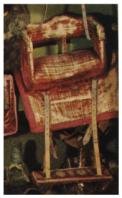
 The riding habits worn by women riding sidesaddle originally were similar to clothing worn in everyday life. It wasn’t until the second half of the 16th century that a riding habit specifically designed for sidesaddle riding was introduced, though sidesaddle habit design still tended to follow fashion of the day.
The riding habits worn by women riding sidesaddle originally were similar to clothing worn in everyday life. It wasn’t until the second half of the 16th century that a riding habit specifically designed for sidesaddle riding was introduced, though sidesaddle habit design still tended to follow fashion of the day.
In the 1700's much of the riding fashions tended towards a military style-- women in tricorns and habits cut to look like cavalry outfits.
As you go later into the 1700's the waistlines go up on all women's fashions, riding habits included. From the late 1700's to the 1800's, women's fashions move into the classical design--close to the body, light corsets, short hair.
Riding fashions for that era were military in design or coats like a man's coat. All side saddle habits need a skirt that is longer on the left (to make the drape over the side). So most anytime you see a woman in a print carrying what looks to be extra skirt on one side -- not a train behind -- she's wearing a riding habit.
Since the mid-17th century, a formal habit for riding sidesaddle usually consisted of:
A tailored jacket with a long skirt (sometimes called a petticoat) to match
A tailored shirt or chemisette
A hat, often in the most formal men's style of the day (since the Victorian era, a top hat with a veil has been worn)
| side saddle leg position |
A hat, often in the most formal men's style of the day (since the Victorian era, a top hat with a veil has been worn)
Low-heeled boots, gloves, and often a necktie or stock completed the ensemble. Typically, throughout the period the riding habit used details from male dress, whether large turned cuffs, gold trims or buttons. The colors were very often darker and more masculine than those on normal clothes
Early side saddles were - literally side saddles - like a chair with a foorplate, the woman would sit - as if in a chair. The saddles were padded and highly decorated - built upon a man's astride saddle. They were little more than stuffed platforms with the lady sitting at a complete right angle to the horse's spine, with her feet resting on a platform called a planchette. Some women probably rode ponies (under 14 hands), even when sitting sideways, they would have had adequate control, but often a servant led them.
 |
| planchette chair saddle |
The sideways facing "chair" was then turned to face the front - think of a typical western (cowboy) saddle with a tall front pommel, but with the saddle bit looking like a chair, with a high back (like a chair) The lady would face front, her back supported by the "chair" with her right leg hooked round the pommel. In the 16th century Catherine de Medici is credited with being the inventor of a second pommel/horn between which the lady placed her right leg and so faced forward, but Albert Durer's etchings of 1497 and 1504 show ladies facing the front of their saddles long before Catherine's second horn. (the forward facing chair saddle?)

 The horn gave women a more secure seat and independent control of their horses, and enabling faster gaits.Despite cultural pressures, not all women of nobility adopted the sidesaddle at all times. Some ladies did ride astride, particularly when hunting (too fast a pace for the literally sitting sideways saddles mentioned above.) However, a big problem was what to wear underneath! Either women donned men's hose or breeches, or they had very chafed thighs.
The horn gave women a more secure seat and independent control of their horses, and enabling faster gaits.Despite cultural pressures, not all women of nobility adopted the sidesaddle at all times. Some ladies did ride astride, particularly when hunting (too fast a pace for the literally sitting sideways saddles mentioned above.) However, a big problem was what to wear underneath! Either women donned men's hose or breeches, or they had very chafed thighs. Women such as Diane de Poitiers (mistress to Henry II of France) and Marie Antoinette were known to ride astride. Catherine the Great of Russia went so far as to commission a portrait showing her riding astride wearing a male officer's uniform. Queen Elizabeth I rode side saddle on ceremonial occasions
Women such as Diane de Poitiers (mistress to Henry II of France) and Marie Antoinette were known to ride astride. Catherine the Great of Russia went so far as to commission a portrait showing her riding astride wearing a male officer's uniform. Queen Elizabeth I rode side saddle on ceremonial occasions

I really impressed by your post. Thank you for this great post, you write very well which i like very much.
ReplyDeleteUtah National Park Horseback Ride
This blog is really informative. Best casual horse riding wear provider offers girls and women’s equestrian clothing wear for casual horse riding and show riding. Shop online with free shipping for orders over $150 in Australia.
ReplyDeleteLadies show shirt